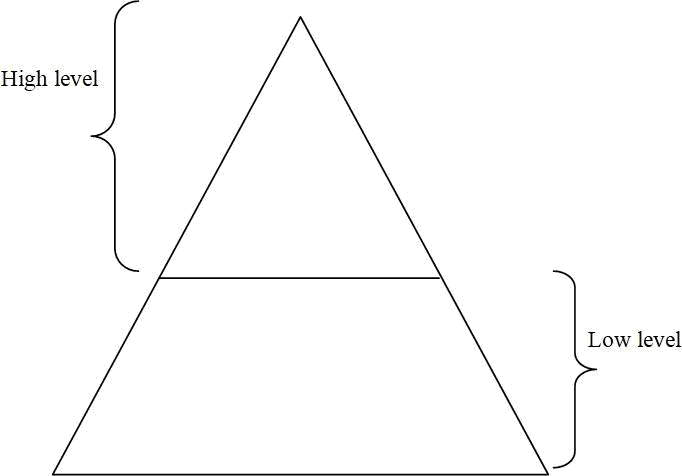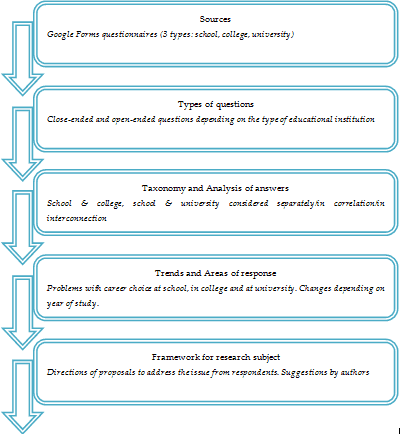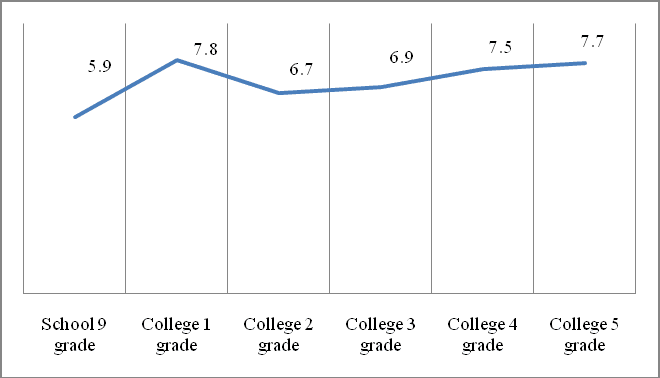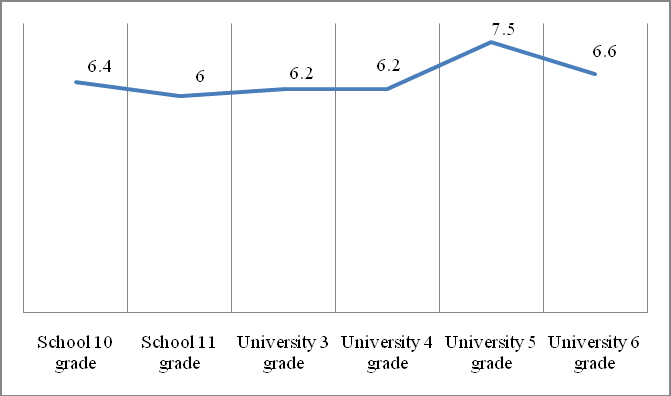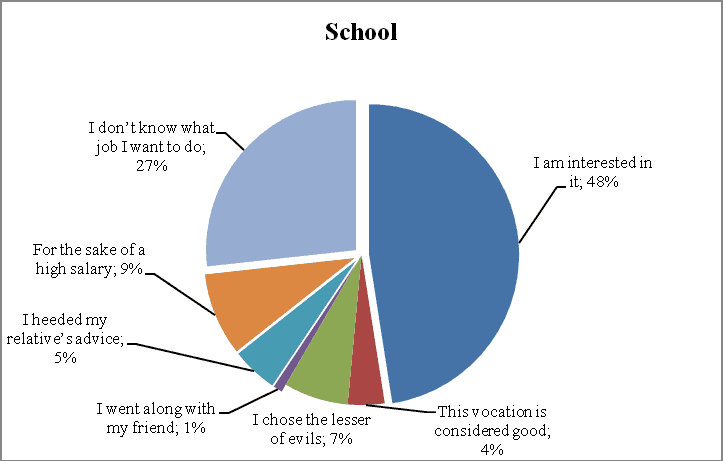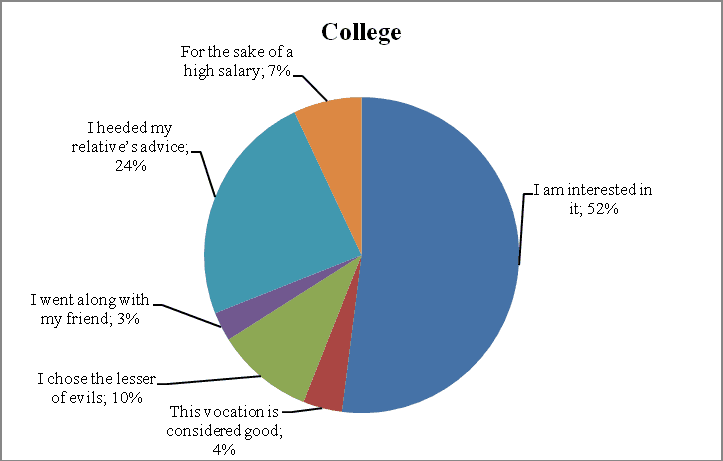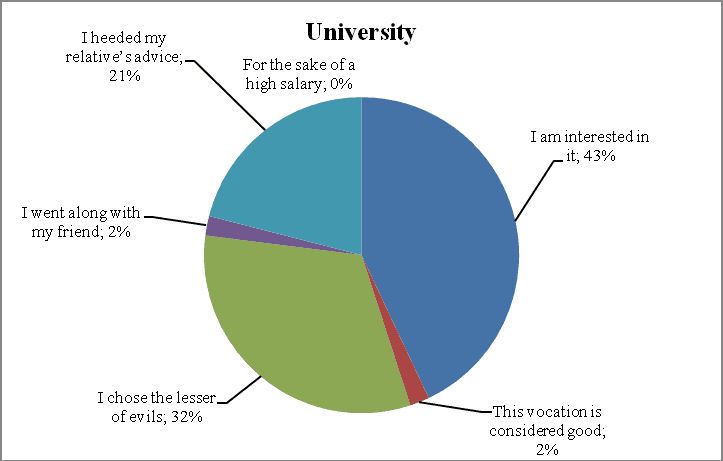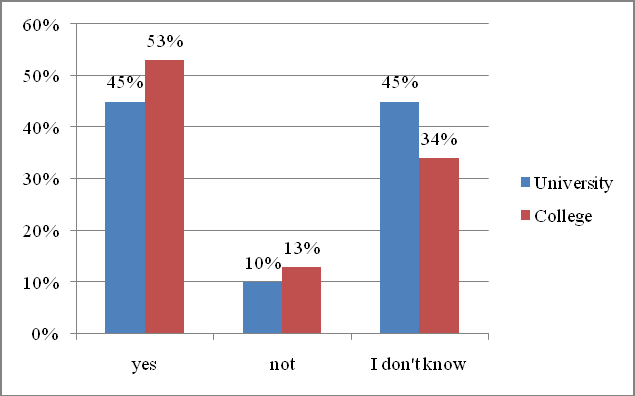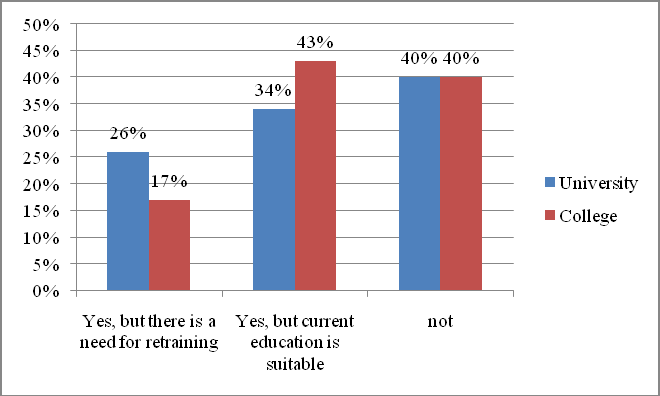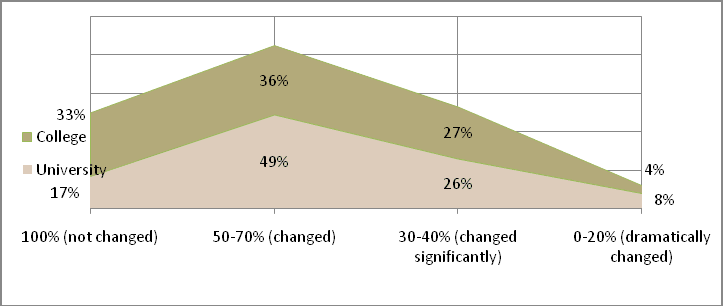Research Article: 2021 Vol: 20 Issue: 2S
The Career Choice Motivation in View of Maslow's Hierarchy in Innovative Economy: The Case of Russia
Sergey Yevgenievich Barykin, Peter the Great St. Petersburg Polytechnic University
Irina Vasilievna Kapustina, Peter the Great St. Petersburg Polytechnic University
Olga Vladimirovna Kalinina, Peter the Great St. Petersburg Polytechnic University
Aleksey Parshukov, Peter the Great St. Petersburg Polytechnic University
Igor Aleksandrov, Peter the Great St. Petersburg Polytechnic University
Marina Fedorova, Petrozavodsk State University
Varvara Maksimovna Poberezhnaya, Peter the Great St. Petersburg Polytechnic University
Eduard Overes, Zuyd University of Applied Sciences
Keywords
Digital Communications, Motivation, Professional Orientation, Innovation Economy
Abstract
The challenge of human resource management is to align with these expectations in order to keep students motivated to choose a complying career in the innovation economy. The research gap concerns a problem of stimulating the employees without-material means if they are not fond of their profession because they cannot achieve their potential. The goals of the study consider analyzing opinions of students of schools, colleges and university about their future profession and determine the problem of professional orientation among students. The article aims to confirm the challenge of choosing a future occupation among students, to determine the factors that influence on their career choice, to assess changes in their attitude towards the chosen occupation in the learning process. The methodology consisted of preparing questionnaires, conducting a survey, grouping responses by category and correlation detection among students of grades 9-11 in 7 schools, one college and university students of years 3-6. It was found that there is a high likelihood of complete coincidence between the sympathy to the profession and its choice. We have found that only two-thirds of students admitted that their expectations about their line of work coincided with the real situation. According to the results, only half of school students choose their specialty because of personal interest, half of college and university students are interested in their specialty and enthusiastic about it, and less than half of the students intend to work in their field. Further research is needed to classify career guidance tools, evaluate their effectiveness, and develop virtual tools.
Introduction
The issues related to improving productivity and efficiency have never lost their relevance. During the 20th–21st centuries, the study of human resource management has passed through several stages of development. Before giving a brief outline of these stages, we would like to start with the end in mind: organizations have to better understand the role that culture plays in boosting open innovation dynamics and motivation amongst employees (Yun et al., 2020). Education is more and more focused at appealing to the students’ interest and teaching students to be innovative and creative, which also creates expectations for their professional career. Motivation is generally seen as the effectiveness of tools influencing an existing staff member. However, in our opinion, not enough attention is paid to the issue of the primal factor of personal motivation which is vocational orientation. This determines the motivation of the future employee. This situation is not only a problem of the enterprise, low labor productivity, poor moral climate, but also a human tragedy. Vocational orientation is a source of motivation; it is a factor that determines the quality of the country’s labor resources. It partially affects the level of frictional unemployment, like an indicator of young professionals looking for their place in the labor market, and the right choice of career is a reduction of the stress level, subsequently preserving the mental and physical health of employees and their families.
The research gap concerns a problem of stimulating the employees without-material means if they are not fond of their profession because they cannot achieve their potential. Finding an interesting vocation is a serious challenge and task for young people. Getting an education for career a student will not pursue is a serious mistake, it is a big loss of time (years) and money, and sometimes losing one’s identity. So, undoubtedly, using non-material stimulation for an employee who does not like the occupation is a doubtful prospect. The article covers analyzing opinions of students of schools, colleges and university about their future profession and determine the problem of professional orientation among students. The aim of the research regards the challenge of choosing a future occupation among students, to determine the factors that influence on their career choice, to assess changes in their attitude towards the chosen occupation in the learning process.
The authors provide the expanded statistics of the survey among 9-11 grade school students (78 people participated in the survey) of 7 schools in Saint Petersburg (Russia), a survey of college students of year 1-5 (70 people) and the results of a survey among university students (47 people). We also provide a list of means that, in the opinion of respondents, can help them make a more informed choice of their future vocation.
Material and Methods
Theoretical Fundamentals and Methodology of the Research
In the early stages of capitalist labor relations, the employee was treated as an element that was easy to replace and needed to be strictly controlled. The staff member was believed to work only to meet the lowest needs, working to live (according to Maslow’s Pyramid) (Maslow, 1943). Initially, there is a need; externally, it manifests itself in the motives for achieving a certain goal, assessing the various options, the individual chooses the option that seems most advantageous. Accordingly, the external impact on the employee in the form of stimulation links purpose and motive by defining the employee’s actions in such a way that they are directed in a way beneficial to the organization.
The advance of technologies (Barykin et al., 2020) and the growing quality of education created an objective need to retain and train employees, using their internal resources and human capital.
Due to the improved labor conditions and educational level of employees, the challenge for HR is to satisfy the so-called higher order needs Maslow has been addressing. Inclusion and self-development have become important factors in the career choices of people. The rise of social media, as example of the aforementioned advanced technologies, has had its impact on how people work. Knowledge can more easily copied becomes obsolete faster and faster, which make new ways of working more important than ever. The focus has become less on processing knowledge, and more on sharing knowledge; Protection will be replaced by co-creation. Open innovation and the sharing of knowledge will be having a more prominent role in a sustainable work environment and will play an important role in motivation of employees. Thus, as a result of the development of HR management concepts, much attention has been paid to the staff motivation, including non-material.
Maslow’s hierarchy of needs below shows different sources, ascribing to it a different number of levels of needs, which is not that important in our case. The division of human needs into two large groups (basic and highest needs) is the main feature to which we draw attention. We would like to emphasize the connection between professional orientation and the highest needs (see Figure 1).
Maslow’s hierarchy is shown conditionally, in our case the emphasis is on the division of needs. It is known that it is relatively easy to satisfy the basic needs of the low levels, it can be done by means of material methods of stimulating work (taking into account the decreasing marginal utility of money: the more we give the employees the less they feel it). But material methods of stimulation are ineffective in meeting the higher needs (and stimulating the worker's labor). The diagram of the human motivation process is shown in Figure 2.
Material stimulation is a simple and easy way to manage employees, but its effectiveness dramatically decreases in meeting the needs of the lower level of the employee, then it is necessary to widely apply non-material stimulation (interesting tasks, projects, etc.) aimed at ensuring the employee’s needs for self-realization and self-development. Ignoring this fact can lead to an imbalance between the employee’s interests and the employer’s proposals and, as a result, loss of influence and staff loyalty. At the same time, there is a situation when the employee works hard and the employer applies broad methods of stimulating, but the labor's effectiveness is still unsatisfactory. Why is that happening? In that case the main problem is that both the employee and the employer are mistaken in understanding the employee’s higher needs.
The authors consider two situations:
1. An employee who does not like the profession got a job in a company.
2. An employee by trade who adores the vocation got a job in a company.
The difference in the level of internal motivation to work is obvious.
The reasons why situation #1 took place could be:
a) The employee knows and hides the dislike towards profession, but needs the money (either at this moment, or believing that it is too late to retrain. This employee works under duress);
b) The employee has not yet realized the dislike towards the profession.
Employee in the situation #1 is not a bad employee and may sincerely try to work hard, but it is unlikely that the results will be higher than "average". At the same time, the employee will work mainly due to willpower for as long as possible. In contrast, employee in the situation #2 will work with inspiration and enthusiasm.
Maybe the employee just does not know other occupations and that makes impossible to determine the scope of their professional activity by interest. The reasons for the lack of knowledge may be different, we can recall Festinger’s theory of cognitive dissonance: the employee does not like the job but suppresses this feeling and avoids information that will support this opinion (Festinger, 1957).
The authors find important the problem being discovered in various articles: there was an assessment and comparison of the level of understanding of the future profession among school and university students (Parshukov, Bril & Krolivetskaya, 2020). We found similar studies suggesting different ways to tackle the problem (Guo & Li, 2020; Garza et al., 2020; Solovyev, Makarenko & Petrova, 2020; Vlasova, Abraukhova & Krasnova, 2020)
In this regard, we conducted a study among students in St. Petersburg (Russia), asking questions about choosing a profession: whether school students understand which career path they want to pursue, what or who influences their choices, whether their opinion changes during their study at college and university, whether their interest in the chosen profession persists, what can help them choose a vocation.
The types of questions are grouped in Table 1.
| Table 1 Reasons for Career Choice |
||
|---|---|---|
| Question | Students | |
| Choose your level of education | School, college, university | |
| Type A: I understand what job I want to do Type B: Do you understand your future vocation | A) schools B) college and university | |
| Why did you choose your vocation | School, college, university | |
| Did you use any sources of information to choose your future vocation | School | |
| What would help students make the right choice of vocation (what resources, activities)? | School | |
| I like my specialty | College, university | |
| I want to work in another field | College, university | |
| Evaluate the level of compliance with your understanding of your vocation now and earlier | College, university | |
The research methodology is shown in Figure 3.
The authors conducted a survey among 9–11 grade students in 7 schools (78 responses), 1–5 year college students (70 responses) and 3–6 year university students (47 responses).
A Google Forms application was used to conduct the study and three types of questionnaires were developed based on this resource: for school, for college and for university. The questionnaires contained several identical questions and several that differed.
The recurring questions included, for example, clarification of the reason for choosing a profession.
College and university students were asked to assess whether their expectations of the profession had been met, now that they had become familiar with the syllabus. They were also asked to assess whether they liked their profession and whether they were ready to work in it. The students also assessed in general how well they understood their profession.
School students, on the other hand, were asked an open question, to suggest tools that would help them become more familiar with the different professions. They were also asked about the source of information that they used to choose their future vocation.
Literature Review
A job occupies a large part of every person’s life and it is an important component in the overall well-being. The success of any organization depends on employees and their ideas and innovations. The question of whether the next idea will become an innovation depends on both the quantity and quality of the ideas themselves. For example, Christensen noted the importance of diagnosing ‘disruptive innovations’ (Christensen, Olesen & Kjær, 2005), in this regard, people who do not practice their profession will not be able to be effective enough. Insufficient motivation to work will be one of the constraints. A considerable number of works examine issues of material and non-material motivation of labor and pay attention to further changes in labor markets and new occupations because of the Fourth Industrial Revolution (Goncharenko et al., 2019; Leopold, Ratcheva & Zahid, 2018). So, the problem of vocational orientation will become more difficult. At the same time, high dependence of the labor market from modern technologies (including digitalization and on-demand economy, job automation) change the process of labor organization (Arntz, Gregory & Zierahn, 2016; Autor, 2015; Barykin et al., 2020; Chinoracký & ?orejová, 2019). Goos et al. pay attention to the great role of innovations and their impact on the labor market. The authors found the existence of a high-tech job multiplier, so that one high-tech job creates five additional low-tech jobs in the local area (Goos, Konings & Vandeweyer,2015).
Digitalization and the rapid growth of innovative products in recent years have had a significant impact on labor relations, both in traditional areas of work and in the context of the on-demand economy. The main outcome of these changes is the growing flexibility of interaction and communication between workers and employers (Groen et al., 2017).
Some researchers focus on the problems of quality of labor markets and population employment in different regions (Aleksandrov et al., 2019; Aleksandrov & Fedorova, 2019; Fejling et al., 2019), opportunities and problems of motivation in staff leasing (Evseeva, Evseeva & Kalinina, 2020), considering the relationship between performance and job satisfaction as a strong motivation factor (Andrade & Westover, 2019; Hensel & Visser, 2019; Tella & Ibinaiye, 2020; Yunus et al., 2020). Tom W. Smith has shown in his survey another factor of motivation: a job satisfaction increases with the prestige or social standing of occupations (Smith, 2007). These results emphasize, among other problems, the lack of motivation and low initiative of employees.
Different researchers have focused on the problems of vocational orientation among school students (Johnson & Beehr, 2014; Miloradova & Savina, 2015). For example, Miloradova and Savina pay attention to the factors which influence professional orientation are, citing readiness of an individual to a specific type of work and presence of the abilities for the chosen profession; attitudes, interests, needs, ideals, beliefs and vocation for a particular activity (Miloradova & Savina, 2015). Undoubtedly, the physiological characteristics of a person are the primary factor that determines certain types of activities, temperament features, for example, perseverance or, on the contrary, increased activity.
Many students will not obtain as high a qualification as they could. For example, Solovyev noted that about one-fifth of university students abandon their education and do not get diplomas (especially years 1-3 of study) (Solovyev et al., 2020). Lee and Pang examined the relationship between motivations, learning that adults with higher motivation of personal development tended to perform better in their part-time learning (Lee & Pang, 2014). Career growth opportunities and challenging jobs have a high influence of career expectations on job satisfaction of Generation Y (Kong, Wang & Fu, 2015).
Nowadays, students do not have the luxury of plenty of time for self-exploration, the Fourth Industrial Revolution is having a serious impact on jobs and professions, there is a rapid loss of qualifications, in these circumstances it is particularly important for everyone to choose 'their' profession and use the time to develop knowledge and skills in it (Abramova & Grishchenko, 2020; Gera & Singh, 2019; Novakova, 2020; Works, 2017). Against this background, another challenge arises: in addition to the disappearance of certain professions, there is a parallel emergence of new ones. Undoubtedly, the training of specialists for new areas of activity lags behind. In this regard, it seems important to emphasize the crucial role of information and communication technologies in organizing the labor force in order to solve not only the problem of incorrect occupational choices, but also to reduce the time lag between the emergence of a profession and the training of interested personnel (Biagi & Falk, 2017; Katz, 2017). The concept of social media can be used in this context (Georgescu & Popescul, 2015; Luo et al., 2018). For example, Fossen & Sorgner consider four groups of occupations and their impact on new digital technologies which can be both destructive and transformative, highlighting two strands of change that are the advances in Artificial Intelligence (AI) and computerization probabilities (Fossen & Sorgner, 2019). The estimate for the probability of computerization for 702 occupations is also given by Frey and Osborne (Frey & Osborne, 2017).
We have found that the right choice of a person's job positively influences their subsequent life, strengthening their intention to remain and progress within the industry (Zopiatis, Theocharous & Constanti, 2016). It should be emphasized that modern digital technologies not only provide information about different vocations but also allow to take virtual tours of various fields, regardless of their location. Guo & Li highlight the importance of the modern intelligent system, e-learning facilities and a "human-computer" interaction for orientation and talent training as important means of development, but they also mention that “machine" can’t replace "human", but should assist "human", integrate into "human’s" wisdom, and combine both organically” (Guo & Li, 2020). Vlasova, Abraukhova and Krasnova also (according to the last point of the list of suggestions) note the high importance of involving school students in real work: “connection of a training with real work of the school student; getting a quality product as a result of this activity; joint work” (Vlasova et al., 2020).
Results
There were 195 responses received, including 78 responses from respondents in grades 9-11 of school, 70 responses from respondents in years 1-5 of college, and 47 responses from respondents in years 3-6 of university (years 1 and 2 did not take part in the survey).
The survey of students from different educational institutions was conducted in spring and summer of 2020. Among the schools, there was an emphasis on grades 9-11 as graduate classes. Many 9 grade school students enroll in secondary vocational education institutions. Most of school students of 10 and 11 grades go to higher professional educational institutions.
Thus, the obtained statistics not only present the views of choosing a vocation and the change of attitude towards it, but also compare the collected data for grade 9 of school to college, as well as collected data of grade 11 to university. The survey was conducted using Google Forms, there were 3 independent questionnaires (for school, for college, for university).
The survey structure for school is shown in Table 2.
| Table 2 Survey Form for Schools |
||
|---|---|---|
| No | Question | Answers |
| 1 | Choose your grade | From 9 to 11 |
| 2 | I understand what job I want to do | A rating from 1 (absolutely do not Understand) to 10 (everything is obvious). |
| 3 | Did you use any sources of information to choose your future vocation (there is an opportunity to choose several answers) | - Advice from relatives; |
| - Internet video; | ||
| - Professional literature and articles; | ||
| - Movies about profession; | ||
| - Opinions of friends; | ||
| - Career guidance courses; | ||
| - Didn’t use any; | ||
| - Own version | ||
| 4 | Why did you choose your vocation | - I am interested in it; |
| - This vocation is considered good; | ||
| - I chose the lesser of evils; | ||
| - I went along with my friend; | ||
| - I heeded my relative’s advice; | ||
| - For the sake of a high salary; | ||
| - I don’t know what job I want to do; | ||
| - Own version | ||
| 5 | What would help students make the right choice of vocation (what resources, activities)? | Question for open answer |
The survey structures for college are shown in Table 3.
| Table 3 Survey Form for College |
||
|---|---|---|
| No | Question | Answers |
| 1 | Choose your grade | From 1 to 5 |
| 2 | Do you understand your future vocation | Rate from 1 (I absolutely do not understand) to 10 (everything is obvious and clear). |
| 3 | I like my specialty | - yes; |
| - not; | ||
| - I don’t know | ||
| 4 | I want to work in another field | - Not; |
| - Yes, but current education is suitable; | ||
| - Yes, but there is a need for retraining | ||
| 5 | Why did you choose your vocation | - I am interested in it; |
| - This profession is considered good; | ||
| - I chose the lesser of evils; | ||
| - I went along with my friend; | ||
| - I heeded my relative’s advice; | ||
| - For the sake of a high salary; | ||
| - Own version | ||
| 6 | Evaluate the level of compliance with your understanding of your vocation now and earlier | - 100% (not changed), |
| - 50–70% (changed), | ||
| - 30–40% (changed significantly), | ||
| - 0–20% (dramatically changed). | ||
The structure of the survey for the university is similar to Table 2. The only difference are possible options for question #1, "Choose your grade", the answers are offered from grade 1 to 6.
The last question, #6, allows to assess the quality of existing methods of vocational orientation. A high volume of answers in the range from 0% to 40% leads us to conclude that the current sources of information for students' decision-making are ineffective.
The most significant survey results for the year of study are given in Table 4. An indicator "understanding of the future vocation" uses the arithmetic means of responses in every group. Table 3 also shows the percentage of the choice based on personal interest in this profession (the answer to the question concerns the reason of choosing a vocation is "I'm interested in it").
| Table 4 Future Vocation |
|||
|---|---|---|---|
| Year | Number of answers | Understanding of the Future Vocation, Average | Interested in their Vocation, % |
| School Grade 9 | 29 | 5.9 | 45% |
| School Grade 10 | 23 | 6.4 | 65% |
| School Grade 11 | 26 | 6.0 | 35% |
| College Year 1 | 9 | 7.8 | 56% |
| College Year 2 | 20 | 6.7 | 50% |
| College Year 3 | 14 | 6.9 | 50% |
| College Year 4 | 24 | 7.5 | 54% |
| College Year 5 | 3 | 7.7 | 33% |
| University Year 3 | 28 | 6.2 | 46% |
| University Year 4 | 12 | 6.2 | 25% |
| University Year 5 | 2 | 7.5 | 50% |
| University Year 6 | 5 | 6.6 | 40% |
The level of understanding the future vocation in the school–college connection (grade 9 of school and year 1-5 of college) is shown in Figure 4.
By the senior year, the level of understanding of the vocation increases, however, students still do not understand their vocation well enough (7.7/10).
The degree of understanding of the vocation in school – college connection (grade 9 of school and 3-6 years of university) is on Figure 5.
The authors try to consider the reasons of career choices, which were indicated by respondents of various educational institutions (for every institution in general) (see Table 5).
| Table 5 The Reasons for Career Choice |
||||
|---|---|---|---|---|
| # | Answer | School | College | University |
| 1 | I am interested in it | 48% | 52% | 43% |
| 2 | This vocation is considered good | 4% | 4% | 2% |
| 3 | I chose the lesser of evils | 7% | 10% | 32% |
| 4 | I went along with my friend | 1% | 3% | 2% |
| 5 | I heeded my relative’s advice | 5% | 24% | 21% |
| 6 | For the sake of a high salary | 9% | 7% | 0% |
| 7 | I don’t know what job I want to do | 27% | - | - |
A personal interest in choosing a career is about 50% on average. The same data are shown as diagrams in Figures 6–8.
The results show that 27% of school students do not know what job they want to do in the future, while the percentage of influence of relatives' opinions is quite low (5%), and in the college and university it reaches 24% and 21%. Thus, we can assume that most of those who could not make a decision about their vocation, turn to their relatives for advice.
Consider the interest in the profession among college and university students (these are future employees and specialists, many of whom are already involved in labor relations). It is important to emphasize that there is no direct relationship in the data between the year of training and interest in the vocation, and the data obtained do not show any changes. Figure 9 shows the results of the answer to the question "Do you like your vocation?".
The number of positive responses to the question about the interest in the vocation and the number of answers to the question about the reason for choosing it are almost equal, it is an interesting fact. So, at university 45% students like their vocation and 43% of them chose it because of personal interest, at college, 52% and 53%, respectively. It can be hypothesized that most of those who do not like their vocation, or have a difficulty with answering this question, didn’t make the choice because of personal interest.
The answers to the question “Do students plan to work in a different field?” are given in Figure 10.
Only about half of the students intend to work in a professional field they have studied for several years. Approximately the same number of students intends to work in a related field of activity, where their education is suitable. However, it is important to remember that their education is not a fully relevant for the new area, which has a negative effect on the level of qualification. Students who want to change their field and have to retrain face two possible career options. First is to work temporarily (while they are retraining) in the field that they do not like. Second is not to retrain and to obtain the experience during their work (if they get to be hired for a position they want to do). All of that will affect their motivation in a bad way.
However, 60% of graduates (plan to work in another field) will not work as effectively as they could.
The level of compliance student's understanding of their future vocation now and earlier showed on Figure 11. The Figure shows the overall response statistics without taking the year of education into account.
Approximately 30% of university and college students realized during their studies that the chosen vocation did not meet their expectations, i.e., their opinion was initially wrong, which can be a problem of vocational orientation (bad quality of information sources, a lack of professional information).
Below we will present some communication tools that were offered by the respondents of 7 schools, 78 students (the whole sample will not be given due to the wide variety of response options). Here are the most constructive suggestions that can be implemented in a short term; they are often found among the answers:
• Meetings and conversations with representatives of different professions;
• Enlightening professional forums;
• Meetings and lectures in schools with representatives of professional educational institutions, where they will talk about the specialties of their organization (this tool is used by various institutions, but not everywhere);
• Tours to enterprises to see the work of different specialists live, participation in the work;
• Articles and videos about professions;
• Involvement in various forms of work at home and during study before entering professional educational institutions.
Thus, various tools are offered to inform young people about different vocations (majority students expect assistance from the outside).
Discussion
This study is local but it is a source of important information. It is necessary to conduct a more extensive survey of students for a better understanding of the situation in the country. At the same time, it is necessary to investigate the existing means of vocational orientation of young people to find solutions to improve the current situation.
Undoubtedly, implementing such measures nationally requires lots of resources and time, but modern technologies allow us to find other solutions in order to improve informational support of young people in order to help them choose their vocation. As a principal instrument, we can create a video channel to conduct short interviews with representatives of different professions (questions could be prepared by students in advance), it can also include companies' videos about their work. This vocational guidance tool is seen as available for implementation with a limited resource base and is relevant nowadays to high technology.
It is necessary to consider the possibility of developing relevant tools of informing about various vocations. There were also interesting ideas for further research such as exploring popular job search websites, conducting analytical research on supply and demand market, studying the requirements and job descriptions and making a well-considerate decision about the vocation you like the most.
Conclusion
The advance of technologies and the growing quality of education created an objective need to retain and train employees, using their internal resources and human capital. Due to the improved labor conditions and educational level of employees, the challenge for HR is to satisfy the so-called higher order needs Maslow has been addressing. Inclusion and self-development have become important factors in the career choices of people. The rise of social media, as example of the aforementioned advanced technologies, has had its impact on how people work. Knowledge can more easily copied becomes obsolete faster and faster, which make new ways of working more important than ever. The focus has become less on processing knowledge, and more on sharing knowledge; Protection will be replaced by co-creation. Open innovation and the sharing of knowledge will be having a more prominent role in a sustainable work environment and will play an important role in motivation of employees. Thus, as a result of the development of HR management concepts, much attention has been paid to the staff motivation, including non-material.
Based on the research, a number of conclusions can be drawn:
• About one-third of students radically change their opinion about their vocation during the education;
• Thereby, the means of vocational orientation of students have a poor quality;
• Only half of students choose a vocation based on their personal interests;
• Only half of students like their profession, identifying personal interest as the reason for the choice;
• Only 40% of students intend to practice the profession they studied, citing interest in the vocation, and identifying personal interest as the reason for the choice;
• Half of students choose a vocation based on the opinions of others.
The authors could prove that there is a high likelihood of complete coincidence between liking the profession choosing it: for example, at university, 45% of students have a genuine interest in their program and 43% chose it based on their personal interests, at college, 52% like the profession and 53% of respondents chose it based on their interest.
Vocational guidance is a very important factor in the formation of the workforce, and can be said to be the fundamental factor determining the level of motivation to work in a profession. In this regard, we should to avoid an imbalance between the employee’s interests and the employer’s proposals and, as a result, loss of influence and staff loyalty. Thus, the problem of vocational orientation of young people is quite serious and requires certain measures and solutions to be implemented.
Author Contributions
All authors have contributed substantially to the entire work reported. All authors have read and approved the final manuscript.
Funding
This research work was supported by the Academic Excellence Project 5-100 proposed by Peter the Great St. Petersburg Polytechnic University.
Conflicts of Interest
The authors declare no conflict of interest.
References
- Abramova, N., & Grishchenko, N. (2020). ICTs, labour productivity and employment: Sustainability in industries in russia. Procedia Manufacturing. Elsevier B.V, 43, 299–305.
- Aleksandrov, I., Burmistrov, A., Rasskazova, O., & Fedorova, M. (2019). Self-development of rural areas under digital economy conditions as exemplified by northwestern federal district regions. IOP Conference Series: Materials Science and Engineering, 497(1).
- Aleksandrov, I.N., & Fedorova, M.Y. (2019). Digital economy and green economy: Rural unemployment and territorial self-development in Russia. E3S Web of Conferences, 110, 1–10.
- Andrade, M.S., & Westover, J.H. (2019). Global comparisons of job satisfaction across occupational categories. Evidence-based HRM.
- Arntz, M., Gregory, T., & Zierahn, U. (2016). The risk of automation. OECD Social, Employment and Migration Working Paper.
- Autor, D.H. (2015). Why are there still so many jobs? the history and future of workplace automation. Journal of Economic Perspectives, 29(3), 3–30.
- Barykin, S., Kalinina, O., Aleksandrov, I., Konnikov, I., Yadikin, V., & Draganov, M. (2020). Personnel management digital model based on the social profiles’ analysis. Journal of Open Innovation: Technology, Market, and Complexity, 6(4), 1–20.
- Barykin, S.Y., Kapustina, I.V., Sergeev, S.M., Kalinina, O.V., Vilken, V.V., de la Poza, E.Z., …& Volkova, L.V. (2021). Developing the physical distribution digital twin model within the trade network. Academy of Strategic Management Journal, 20(1), 1–24.
- Barykin, S.Y., Bochkarev, A.A., Kalinina, O.V., & Yadykin, V.K. (2020). Concept for a supply chain digital twin. International Journal of Mathematical, Engineering and Management Sciences, 5(6), 1498–1515.
- Biagi, F., & Falk, M. (2017). The impact of ICT and e-commerce on employment in Europe. Journal of Policy Modeling.
- Chinoracký, R., & ?orejová, T. (2019). Impact of digital technologies on labor market and the transport sector. Transportation Research Procedia, 40,994–1001.
- Christensen, J.F., Olesen, M.H., & Kjær, J.S. (2005). The industrial dynamics of open innovation - Evidence from the transformation of consumer electronics. Research Policy, 34(10), 1533–1549.
- Evseeva, S., Evseeva, O., & Kalinina, O. (2020). HR staff leasing: Opportunities in the digital economy environment (case of Russia). E3S Web of Conferences, Rudoy D, Ignateva S (eds) 175,13041.
- Fejling, T., Torosyan, E., Tsukanova, O., & Kalinina, O. (2019). Special aspects of digital technology-based brand promotion. IOP Conference Series: Materials Science and Engineering, 497(1).
- Festinger, L. (1957). A theory of social cognitive dissonance. Human Relations.
- Fossen, F., & Sorgner, A. (2019). Mapping the future of occupations: Transformative and destructive effects of new digital technologies on jobs. Foresight and STI Governance.
- Frey, C.B., & Osborne, M.A. (2017). The future of employment: How susceptible are jobs to computerisation? Technological Forecasting and Social Change, 114, 254–280.
- Georgescu, M., & Popescul, D. (2015). Social media – The new paradigm of collaboration and communication for business environment. Procedia Economics and Finance. Elsevier B, 20(2012), 277–282.
- Gera, I., & Singh, S. (2019). An inquiry into the impact of the fourth industrial revolution on employment: A Review. SSRN Electronic Journal.
- Goncharenko, O. (2019). Improving staff stimulation systems: Causal-consequence approach. International Journal of Engineering and Advanced Technology.
- Goos, M., Konings, J., & Vandeweyer, M. (2015). Employment growth in europe: The roles of innovation, local job multipliers and institutions. SSRN Electronic Journal.
- Groen, W.P., de Lenaerts, K., Bosc, R., & Paquier, F. (2017). Impact of digitalisation and the on-demand economy on labour markets and the consequences for employment and industrial relations. European Economic and Social Committee: Bruxelles, Belgium.
- Guo, W.W., & Li, T. (2020). Accounting professional orientation and talent training based on artificial intelligence. In Journal of Physics: Conference Series.
- Hensel, R., & Visser, R. (2019). Does personality influence effectual behaviour? International Journal of Entrepreneurial Behaviour and Research.
- Johnson, V.A., & Beehr, T.A. (2014). Making use of professional development: Employee interests and motivational goal orientations. Journal of Vocational Behavior. Elsevier Inc. 84(2),99–108.
- Katz, R.L. (2017). Social and economic impact of digital transformation on the economy. ITU Gsr-17 DIscussion Paper. International Telecommunication Union (ITU), Geneva, Switzerland.
- Kong, H., Wang, S., & Fu, X. (2015). Meeting career expectation: Can it enhance job satisfaction of generation Y? International Journal of Contemporary Hospitality Management, 27(1),147–168.
- Lee, P.L., & Pang, V. (2014). The influence of motivational orientations on academic achievement among working adults in continuing education. International Journal of Training Research.
- Leopold, T.A., Ratcheva, V.S., & Zahid, S. (20180. The future of jobs report. Economic Development Quarterly, 31.
- Luo, N., Guo, X., Lu, B., & Chen, G. (2018). Can non-work-related social media use benefit the company? A study on corporate blogging and affective organizational commitment. Computers in Human Behavior. Elsevier Ltd, 81, 84–92.
- Maslow, A.H. (1943). A theory of human motivation. Psychological Review.
- Miloradova, N., & Savina, E. 2015. Problem of professional personality orientation formation of a future builder and architect. Procedia Engineering. Elsevier B.V, 117(1), 252–257.
- Novakova, L. (20200. The impact of technology development on the future of the labour market in the Slovak Republic. Technology in Society. Elsevier Ltd, 62, 101256.
- Parshukov, A., Bril, A., & Krolivetskaya, S. (2020). Professional orientation of students as the basis of future labour motivation. E3S Web of Conferences, Zheltenkov A, Mottaeva A (eds), 164, 12012.
- Garza, Q.M.E., Marín, F.D.L., Hernández, C.R.R., Rojas, E.I.E., & Cabrera, L.M.V. (2020). Effects of a vocational program on professional orientation. Heliyon, 6(4), e03860.
- Smith, T.W. (2007). Job Satisfaction in the United States , 1–9.
- Solovyev, A., Makarenko, E., & Petrova, L. (2020). The problem of dropout from technical universities: Early professional orientation approach. In Advances in Intelligent Systems and Computing.
- Tella, A., & Ibinaiye, O.A. 2020. Correlates of staff motivation, satisfaction, and job performance of library staff in selected Nigerian University libraries. International Information and Library Review.
- Vlasova, T., Abraukhova, V., & Krasnova, E. 2020. Professional orientation of schoolchildren living in the agricultural region of Russia, based on social and pedagogical partnership. E3S Web of Conferences, 175, 15010.
- Works, R. (2017). The impact of technology on labor markets. Monthly Labor Review.
- Yun, J.H.J., Zhao, X., Jung, K.H., & Yigitcanlar, T. (2020). The culture for open innovation dynamics. Sustainability (Switzerland), 12(12).
- Yunus, M., Yusuf, I.E., Adam, M., & Sofyan, H. (2020). Does motivation mediate the effects of employee staff empowerment, talent, working environment, and career development on staff performance? Quality - Access to Success.
- Zopiatis, A., Theocharous, A.L., & Constanti, P. (2016). Adult vocational decision, career satisfaction and future intention: Insights from the hospitality industry. International Journal of Contemporary Hospitality Management, 28(12), 2696–2720.
